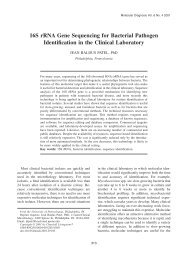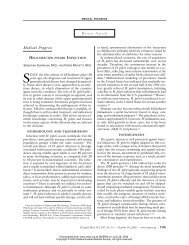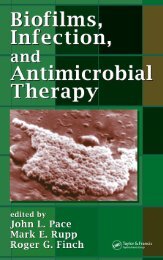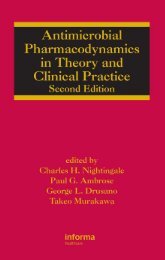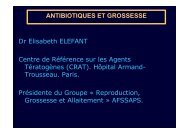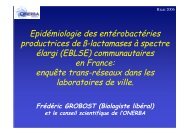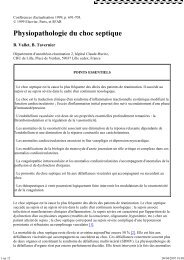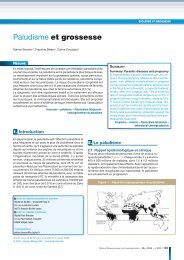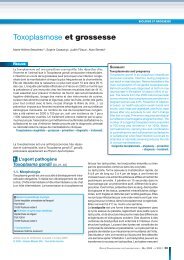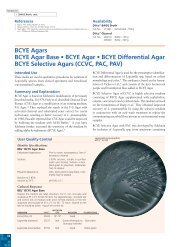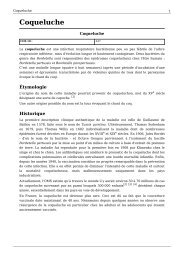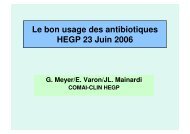Principles and Practice of Clinical Bacteriology Second Edition - Free
Principles and Practice of Clinical Bacteriology Second Edition - Free
Principles and Practice of Clinical Bacteriology Second Edition - Free
Create successful ePaper yourself
Turn your PDF publications into a flip-book with our unique Google optimized e-Paper software.
24 ORAL AND OTHER NON-β-HAEMOLYTIC STREPTOCOCCI<br />
involved in many types <strong>of</strong> infections, in which the source <strong>of</strong> the infection<br />
is almost invariably endogenous, being derived from the host’s micr<strong>of</strong>lora.<br />
The streptococcal species themselves are generally thought to<br />
be <strong>of</strong> relatively low virulence, not normally associated with acute,<br />
rapidly spreading infections such as those caused by Streptococcus<br />
pyogenes, although they clearly have phenotypic features that result in<br />
the production <strong>of</strong> disease under appropriate circumstances.<br />
Since many <strong>of</strong> these streptococci are present in the mouth, upper<br />
respiratory tract, genitourinary tract <strong>and</strong>, to a lesser extent, gastrointestinal<br />
tract, they are sometimes involved in pathological processes at<br />
these sites, possibly following some local or systemic change in<br />
host susceptibility or an alteration in local environmental conditions.<br />
A classic example is the manifestation <strong>of</strong> dental caries that arises<br />
following excessive consumption <strong>of</strong> dietary sugars, particularly<br />
sucrose. Alternatively, the streptococci at a mucosal site may gain<br />
access to the blood stream because <strong>of</strong> some local traumatic event <strong>and</strong><br />
set up an infection at a distant location, such as the heart valve in<br />
endocarditis or in the brain or liver, giving rise to an abscess. The key<br />
event for infections at distant body sites is bacteraemia.<br />
Epidemiology<br />
Our underst<strong>and</strong>ing <strong>of</strong> the importance <strong>of</strong> non-β-haemolytic streptococci<br />
as bacteraemic pathogens has been hampered by a dearth <strong>of</strong> surveillance<br />
activity in many countries. Robust estimates <strong>of</strong> incidence have been,<br />
<strong>and</strong> to a degree remain, few <strong>and</strong> far between. Most quantitative studies<br />
undertaken have been based on case series originating from localized<br />
areas whose catchment populations are <strong>of</strong>ten difficult to enumerate<br />
<strong>and</strong>, therefore, difficult to translate into estimates <strong>of</strong> incidence.<br />
In Engl<strong>and</strong> <strong>and</strong> Wales a comprehensive laboratory-based surveillance<br />
network gathers reports <strong>of</strong> bacteraemia caused by all pathogens. Data<br />
from this surveillance on non-β-haemolytic streptococci indicate an<br />
incidence <strong>of</strong> 3.8 per 100 000 population in 2002 (HPA, 2003a).<br />
Non-β-haemolytic streptococci comprised approximately 3% <strong>of</strong> all<br />
bacteraemia reported through this system (HPA, 2002), broadly in line<br />
with estimates from other European countries <strong>and</strong> the Americas, which<br />
range from 1.5% to 5.9% (Jacobs et al., 1995; Casariego et al., 1996;<br />
Diekema et al., 2000; Fluit et al., 2000).<br />
Of the non-β-haemolytic streptococci, mitis group organisms<br />
appear to be the most common cause <strong>of</strong> bacteraemia overall (Venditti<br />
et al., 1989; Doern et al., 1996; HPA, 2003a), the rate <strong>of</strong> reports in<br />
Engl<strong>and</strong> <strong>and</strong> Wales being 1.4 per 100 000 population in 2002, with<br />
S. oralis being the most common single species identified (12% <strong>of</strong> all<br />
non-β-haemolytic streptococci). A smaller study from The Netherl<strong>and</strong>s<br />
similarly found S. oralis to be the most common non-β-haemolytic<br />
streptococci causing bacteraemia, particularly associated with infection<br />
in haematology patients (Jacobs et al., 1995). Studies focusing on<br />
neutropenic patients, one <strong>of</strong> the most vulnerable patient groups,<br />
suggest that between 13% <strong>and</strong> 18% <strong>of</strong> bacteraemias are due to nonβ-haemolytic<br />
streptococci (Wisplingh<strong>of</strong>f et al., 1999; Marron et al.,<br />
2001), with S. mitis featuring as one <strong>of</strong> the most prominent species<br />
(Alcaide et al., 1996).<br />
Interestingly, the relative contribution <strong>of</strong> each non-β-haemolytic<br />
streptococcal group to bacteraemic episodes in Engl<strong>and</strong> <strong>and</strong> Wales<br />
has changed over 1990–2000. The incidence <strong>of</strong> the formerly dominant<br />
sanguis group (S. sanguis, S. parasanguis <strong>and</strong> S. gordonii) has<br />
declined by half, whereas those <strong>of</strong> mitis <strong>and</strong> anginosus group streptococci<br />
have increased dramatically by three- <strong>and</strong> tw<strong>of</strong>old, respectively<br />
(Figure 2.2).<br />
Estimates <strong>of</strong> the relative importance <strong>of</strong> healthcare exposure in the<br />
aetiology <strong>of</strong> non-β-haemolytic streptococcal bacteraemia have<br />
differed between studies. Two studies <strong>of</strong> S. bovis bacteraemia in Hong<br />
Kong (Lee et al., 2003) <strong>and</strong> Israel (Siegman-Igra <strong>and</strong> Schwartz, 2003)<br />
found none <strong>and</strong> 10% <strong>of</strong> cases, respectively, to have been hospital<br />
acquired, whereas 6 <strong>of</strong> 31 (19%) S. milleri bacteraemias identified in<br />
a case series from Spain were considered to be hospital acquired<br />
Rate per 100 000 population<br />
1.6<br />
1.4<br />
1.2<br />
1.0<br />
0.8<br />
0.6<br />
0.4<br />
0.2<br />
0.0<br />
1990 1991 1992 1993 1994 1995 1996 1997 1998 1999 2000 2001 2002<br />
(Casariego et al., 1996). Nosocomial infection surveillance from the<br />
United States (Emori <strong>and</strong> Gaynes, 1993; Pfaller et al., 1997) <strong>and</strong><br />
Engl<strong>and</strong> (NINSS, 2003) identified between 1% <strong>and</strong> 3% <strong>of</strong> hospitalacquired<br />
bacteraemia to involve non-β-haemolytic streptococci.<br />
Being opportunistic pathogens, bacteraemia involving nonβ-haemolytic<br />
streptococci tend to be concentrated in vulnerable<br />
individuals, namely the very young <strong>and</strong> older age groups (Figure 2.3).<br />
Much like many other blood stream infections, non-β-haemolytic<br />
streptococcus infection tends to have rates that are higher in males<br />
than in females, this pattern being seen across all non-β-haemolytic<br />
streptococcal groups (HPA, 2003b) <strong>and</strong> <strong>of</strong>ten also seen in studies <strong>of</strong><br />
infective endocarditis (Mylonakis <strong>and</strong> Calderwood, 2001; Hoen et al.,<br />
2002; Mouly et al., 2002), with some exceptions (Hogevik et al., 1995).<br />
Infective Endocarditis<br />
Anginosus group<br />
Mitis group<br />
Salivarius group<br />
Bovis group<br />
Mutans group<br />
Sanguis group<br />
Figure 2.2 Annual rate <strong>of</strong> laboratory reports <strong>of</strong> bacteraemia caused by nonβ-haemolytic<br />
streptococci, Engl<strong>and</strong> <strong>and</strong> Wales. Source: Health Protection<br />
Agency (Communicable Disease Surveillance Centre).<br />
Infective endocarditis involving non-β-haemolytic streptococci<br />
usually occurs in patients with preexisting valvular lesions <strong>and</strong> is<br />
typically subacute, whereas the acute form <strong>of</strong> endocarditis which can<br />
occur in those with previously undamaged heart valves is associated<br />
with more virulent bacteria such as Staphylococcus aureus, S. pyogenes<br />
or S. pneumoniae. Patients at particular risk <strong>of</strong> developing subacute<br />
endocarditis include those with congenital heart defects affecting<br />
valves, those with acquired cardiac lesions following rheumatic fever<br />
Rate per 100 000 population<br />
4<br />
3<br />
2<br />
1<br />
0<br />
Male<br />
Female<br />




